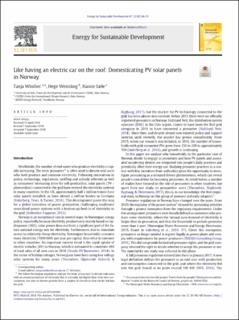| dc.description.abstract | Worldwide, the number of electricity end-users who produce electricity and feed it to the grid, denoted ‘prosumers’, is increasing. Following innovations in policy, technology (e.g. inverters, smart meters), tariffing and subsidy schemes, solar panels (PV – photovoltaic) connected to the grid have entered the electricity systems in many countries such as the UK and Germany. Norway is an exceptional case in several ways. Because electricity production is mainly based on hydropower, PV does not form a significant part of the government’s vision of the country’s future electricity mix. As a result, governance is limited to prosumer regulations that make it possible to become prosumers in a relatively simple way, but do not actively encourage growth in this market, which is mainly demand driven and only slowly increasing. Norway also has a rapid uptake of electric vehicles at present, potentially influencing the way electricity is managed by households. In this context of pioneering prosumer activities in Norway, this study draws on material from 29 in-depth interviews with prosumers located across the country. The objective is to examine people’s rationales for investing in solar power and how they use this technology to signal identity. We draw on consumption and domestication theory as well as practice-oriented approaches to energy use. The results show that at present there are three groups of prosumers in Norway who have followed distinct domestication paths. We denote the groups as individual prosumers (who have taken the initiative to install solar PV), ‘smart house' dwellers and ecovillagers, respectively. All three share an emphasis on self-consumption in terms of maximising electricity use in periods with sunshine. They also make use of solar technology to signal identity (conversion). However, the groups’ styles of prosuming differ. In terms of incorporating the technology in daily life, the individual prosumers closely follow their own production and engage more actively with the monitoring equipment than the two other groups. As to their underlying values and motivations for prosuming, the individual prosumers, who are largely men, emphasise their interest in testing the new technology. The smart house dwellers associate their type of housing with a high level of comfort and consider the PV to signal a modern way of living. The ecovillagers are primarily concerned with environmentally friendly living. The materiality and physical position of the solar panels on the roofs partly help to create social significance, but only because the dwellers and their observers associate the object with particular values. Each of our three groups draws a particular meaning from PV that serves to strengthen their desired identity. The results indicate that PV may have the potential to spread to a variety of energy customer groups in Norway. However, the issue of diffusion is uncertain, partly because the studied groups are pioneers and do not necessarily represent a general segment of the population. Also, the studied prosumers tend to downplay economic profitability as a rationale for obtaining PV, and Norwegian authorities do not actively promote PV through support schemes. | |
